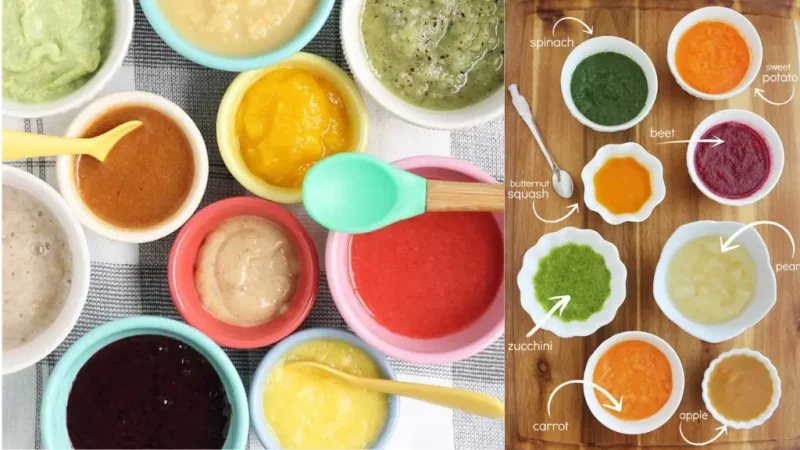Parents rely on store-bought baby food for convenience. But making your baby food at home can be a rewarding and cost-effective alternative. It allows you to control ingredients and ensure your little one gets fresh, nutritious meals.
Homemade baby food is often simpler to prepare than you might think. You can create tasty purees and finger foods tailored to your baby’s needs and preferences with a few basic tools and ingredients.

This article explores the benefits of homemade baby food, essential equipment, and step-by-step guides for preparing fruits, vegetables, and proteins. We’ll also cover food safety, storage tips, and how to introduce new flavours to your baby.
Benefits of Homemade Baby Food
Making your baby food offers several advantages over store-bought options. Let’s explore some key benefits:
Nutritional Control
You have complete control over the ingredients when you prepare baby food at home. This allows you to:
- Choose fresh, high-quality produce
- Avoid added preservatives, sugars, and salt
- Customize recipes to meet your baby’s nutritional needs
- Introduce a wider variety of foods and flavors
Cost-Effectiveness
Homemade baby food can be more economical than store-bought options, especially if you:
- Buy produce in season or bulk.
- Use leftovers from family meals.
- Prepare larger batches and freeze portions
Environmental Impact
By making baby food at home, you can reduce your environmental footprint by:
- Minimizing packaging waste
- Choosing locally sourced ingredients
- Using reusable containers for storage
Essential Equipment for Making Baby Food
Before you start preparing homemade baby food, gather these essential tools:
Food Processor or Blender
A food processor or blender is crucial for pureeing fruits, vegetables, and meats. Look for:
- Easy-to-clean models
- Multiple speed settings
- Durable construction
Steamer Basket
Steaming helps preserve nutrients in fruits and vegetables. Choose:
- A collapsible steamer basket for easy storage
- Stainless steel construction for durability
Storage Containers
Proper storage is essential for food safety. Invest in:
- BPA-free plastic containers or glass jars
- Freezer-safe options
- Various sizes for portion control
Ice Cube Trays
Ice cube trays are perfect for freezing small portions of baby food.
Look for:
- Silicone trays for easy removal
- Trays with lids to prevent freezer burn
Mesh Strainer
A fine-mesh strainer helps achieve smooth purees by removing any lumps or fibers.
Choose:
- A stainless steel filter for durability
- A comfortable handle for easy use
Preparing Fruits for Baby Food

Fruits are an excellent first food for babies, offering natural sweetness and essential nutrients. Here’s how to prepare some common fruits:
Apples
- Wash, peel, core, and chop apples into small pieces.
- Steam until tender (about 8-10 minutes).
- Puree in a food processor, adding cooking liquid as needed.
Bananas
- Peel and mash ripe bananas with a fork.
- For younger babies, puree until smooth.
- No cooking is required.
Pears
- Wash, peel, core, and chop pears into small pieces.
- Steam until tender (about 8-10 minutes).
- Puree in a food processor, adding cooking liquid as needed.
Peaches
- Wash, peel, remove pit, and chop peaches into small pieces.
- Steam until tender (about 5-7 minutes).
- Puree in a food processor, adding cooking liquid as needed.
Preparing Vegetables for Baby Food
Vegetables provide essential vitamins, minerals, and fiber.
Here’s how to prepare some common vegetables:
Sweet Potatoes
- Wash, peel, and chop sweet potatoes into small cubes.
- Steam until tender (about 15-20 minutes).
- Puree in a food processor, adding cooking liquid as needed.
Carrots
- Wash, peel, and chop carrots into small pieces.
- Steam until tender (about 10-12 minutes).
- Puree in a food processor, adding cooking liquid as needed.
Peas
- Use fresh or frozen peas.
- Steam until tender (about 5-7 minutes).
- Puree in a food processor, adding cooking liquid as needed.
Spinach
- Wash fresh spinach thoroughly.
- Steam until wilted (about 3-5 minutes).
- Puree in a food processor, adding cooking liquid as needed.
Preparing Proteins for Baby Food
Proteins are essential for your baby’s growth and development.
Here’s how to prepare some familiar protein sources:
Chicken
- Use boneless, skinless chicken breast.
- Poach or bake until fully cooked (internal temperature of 165°F).
- Puree in a food processor, adding water or broth as needed.
Beef
- Use lean cuts of beef.
- Cook thoroughly in a pan or slow cooker.
- Puree in a food processor, adding water or broth as needed.
Fish
- Choose low-mercury fish like salmon or cod.
- Poach or bake until fully cooked and flaky.
- Puree in a food processor, adding water as needed.
Lentils
- Rinse lentils and remove any debris.
- Cook in water until tender (about 20-30 minutes).
- Puree in a food processor, adding cooking liquid as needed.
Combining Ingredients for Balanced Meals
You can combine different foods as your baby grows to create balanced meals.
Here are some ideas:
Fruit and Vegetable Combinations
- Apple and spinach puree
- Carrot and pear puree
- Sweet potato and peach puree
Protein and Vegetable Combinations
- Chicken and pea puree
- Beef and sweet potato puree
- Lentil and carrot puree
Three-Ingredient Combinations
- Chicken, apple, and spinach puree
- Beef, sweet potato, and pear puree
- Fish, carrot, and pea puree
Food Safety and Storage
Proper food safety and storage practices are crucial when making homemade baby food. Follow these guidelines:
Safe Preparation
- Wash hands thoroughly before handling food
- Clean all utensils and surfaces
- Cook meats to proper internal temperatures
- Avoid honey for babies under one year old due to botulism risk
Storage Guidelines
- Refrigerate freshly made baby food within 2 hours
- Store in the refrigerator for up to 48 hours
- Freeze portions for up to 3 months
- Label containers with contents and date
Thawing and Reheating
- Thaw frozen baby food in the fridge overnight
- Reheat food thoroughly to 165°F
- Stir and test temperature before serving
- Discard any uneaten food from the serving
Introducing New Foods and Flavors
Expanding your baby’s palate helps develop healthy eating habits.
Here are some tips for introducing new foods:
Start with Single Ingredients
- Introduce one new food at a time
- Wait 3-5 days before introducing another new food
- Watch for any signs of allergies or intolerances
Gradually Increase Texture
- Begin with smooth purees
- Progress to mashed foods
- Introduce soft, small pieces for finger foods
Offer a Variety of Flavors
- Include both sweet and savory options
- Introduce herbs and mild spices (avoid salt)
- Don’t give up if a food is initially rejected – it may take multiple tries
Adapting Recipes as Your Baby Grows
As your baby develops, their nutritional needs and eating abilities will change. Here’s how to adapt your homemade baby food:
6-8 Months
- Focus on smooth purees
- Introduce single-ingredient foods
- Gradually increase variety
8-10 Months
- Offer thicker purees and mashed foods
- Begin combining ingredients
- Introduce soft finger foods
10-12 Months
- Provide chopped, soft table foods
- Encourage self-feeding
- Offer a wider variety of flavors and textures
Troubleshooting Common Issues
Even with careful preparation, you may encounter some challenges when making baby food. Here are solutions to common issues:
Lumpy Purees
- Strain purees through a fine-mesh sieve
- Add more cooking liquid and blend again
- Cook ingredients longer for a softer texture
Discoloration
- Add a squeeze of lemon juice to fruits to prevent browning
- Store in airtight containers to minimize oxidation
- Use within recommended time frames
Freezer Burn
- Use freezer-safe containers with tight-fitting lids
- Remove as much air as possible before sealing
- Use frozen baby food within three months
Balancing Homemade and Store-Bought Options
While homemade baby food offers many benefits, it’s okay to use store-bought options when needed. Here’s how to find a balance:
When to Use Store-Bought Baby Food
- During travel or outings
- As a backup when short on time
- To introduce foods you’re less comfortable preparing
Choosing Quality Store-Bought Options
- Read ingredient labels carefully
- Choose options with minimal additives
- Look for organic or non-GMO products if desired
Combining Homemade and Store-Bought
- Use store-bought foods to supplement homemade options
- Mix homemade purees with prepared cereals
- Gradually transition to more homemade foods as you become comfortable
Conclusion
Making your baby food can be a rewarding experience that offers numerous benefits for you and your little one.
Controlling ingredients ensures your baby receives fresh, nutritious meals tailored to their needs. With the right tools and techniques, homemade baby food can be simple and cost-effective.
Always prioritize food safety, introduce new foods gradually, and adapt your recipes as your baby grows.
Whether you choose all of your baby’s food at home or find a balance with store-bought options, the most important thing is to provide your child with various nutritious foods to support their growth and development.
